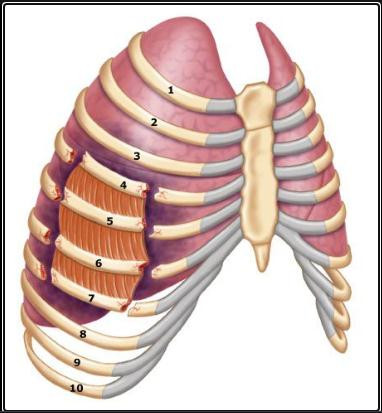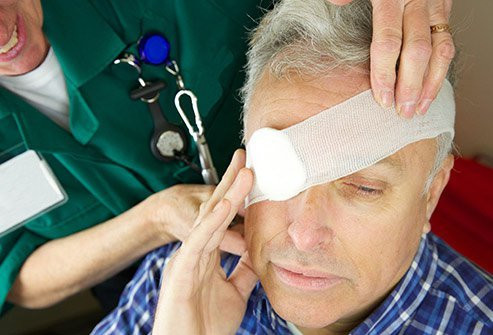Definisi
Di dalam rongga dada, terdapat sistem organ yang berperan penting dalam kehidupan manusia, yaitu saluran napas, organ paru, jantung dan berbagai pembuluh darahnya. Jika terjadi cedera pada area dada karena benturan benda tumpul atau tusukan benda tajam, hal ini dapat menyebabkan gangguan yang signifikan pada organ-organ tersebut. Terjadinya benturan benda tumpul atau tusukan benda tajam pada dada tersebut disebut sebagai trauma dada.
Cedera atau trauma yang terjadi di area dada tidak hanya dapat melukai jantung dan paru saja, namun juga dapat mencederai struktur lain di area dada seperti tulang rusuk, tulang selangka, saluran trakea, kerongkongan dan pembuluh darah besar. Lebih lanjut, trauma dada dapat menyebabkan munculnya gejala dengan berbagai tingkat keparahan, mulai dari gejala ringan hingga yang dapat mengancam jiwa.
Trauma dada dapat terjadi sebagai akibat dari kecelakaan atau penusukan yang disengaja. Benturan akibat benda tumpul merupakan penyebab trauma dada yang paling sering ditemukan. Penyebab lain yang dapat menyebabkan terjadinya trauma dada adalah jatuh dari ketinggian, kekerasan, atau kecelakaan akibat ledakan. Cedera yang diakibatkan oleh trauma dada dapat mengancam jiwa sehingga harus dilakukan evaluasi dan intervensi segera. Cedera yang paling sering terjadi karena trauma dada berupa pneumothorax dan hemothorax.
Penyebab
Trauma dada dikelompokkan berdasaran mekanisme penyebab cedera, yaitu trauma akibat benda tumpul dan trauma penetrasi akibat benda tajam. Cedera yang disebabkan trauma tumpul pada dada lebih sering ditemukan dibanding dengan trauma penetrasi. Orang yang mengalami trauma tumpul pada kecelakaan bermotor berisiko mengalami tingkat kesakitan dan risiko kematian yang tinggi jika tabrakan terjadi dalam kecepatan tinggi dan tidak menggunakan sabuk pengaman.
Trauma tumpul
Trauma akibat benda tumpul mengacu pada benturan pada dada yang menyebabkan peningkatan tekanan di dalam rongga dada. Kondisi yang dikelompokkan ke dalam trauma tumpul adalah tabrakan kendaraan bermotor (penyebab paling umum terjadinya trauma dada), jatuh dari ketinggian, kekerasan dan kecelakaan akibat ledakan. Hanya 10% dari seluruh kasus trauma tumpul pada dada yang memerlukan prosedur pembedahan.
Trauma tajam
Trauma penetrasi akibat benda tajam mengacu pada trauma yang terjadi akibat penembakan, luka tusuk dan luka lain yang menembus rongga dada. Meskipun jumlah kasus trauma tumpul pada dada cenderung tinggi, trauma tajam pada dada menyebabkan angka kematian yang lebih tinggi dibanding trauma tumpul. Lebih lanjut, trauma tajam pada dada juga menyebabkan sekitar 15-30 persen orang yang mengalaminya memerlukan penanganan berupa prosedur pembedahan. Angka tersebut lebih tinggi jika dibanding kasus trauma tumpul pada dada.
Faktor Risiko
Kecelakaan kendaraan bermotor merupakan penyebab yang paling sering terjadinya trauma dada, sebesar 80 persen. Risiko kematian pada kasus trauma dada dapat meningkat dengan drastis pada pasien yang berusia lebih dari 65 tahun, mengalami patah tulang rusuk pada tiga tulang atau lebih, serta adanya penyakit jantung dan paru yang turut dimiliki oleh pasien.
Gejala
Terdapat beberapa gejala yang muncul pada trauma dada, yaitu:
- Kesulitan bernapas
- Dada sulit atau gagal untuk mengembang dengan normal
- Adanya nyeri tekan pada tulang rusuk
- Memar
- Batuk darah
- Salah satu bagian dinding dada mungkin tidak dapat bergerak saat bernapas atau bergerak berlawanan dengan bagian dinding dada lainnya (flail chest)
Diagnosis
Dokter akan melakukan pemeriksaan awal secara cepat pada orang-orang yang datang ke fasilitas kesehatan dengan trauma dada. Pemeriksaan awal yang dilakukan adalah:
- Memeriksa adanya sumbatan pada saluran napas pasien
- Apakah pasien bernapas dengan baik dan kedua sisi dada pasien mengembang dengan simetris
- Bagaimana kondisi denyut nadi dan kulit pasien
- Memeriksa tingkat kesadaran pasien serta tanda dan gejala lain yang terlihat pada tubuh pasien
Dokter juga akan menanyakan bagaimana riwayat kejadian pada orang yang mengantar pasien ke fasilitas kesehatan. Tidak hanya itu, dokter juga akan mengulik riwayat medis pasien lebih dalam. Untuk menengakan diagnosis, terdapat beberapa pemeriksaan penunjang yang mungkin akan dilakukan oleh dokter Anda, yaitu:
Rontgen dada
Sebagian besar trauma dada dapat dievaluasi menggunakan pemeriksaan fisik dan pemeriksaan pencitraan area dada. Pemeriksaan rontgen dada merupakan salah stau jenis pemeriksaan penunjang yang sering dilakukan pada trauma dada karena cepat, mudah diperolah dan mudah diakses.
USG (ultrasound)
Evaluasi dengan menggunakan USG pada kasus trauma atau USG FAST (Focused Assessment with Sonography in Trauma), terfokus untuk memeriksa dan menilai rongga dada serta rongga perut. USG FAST dapat dilakukan dalam fase awal penilaian trauma pada pasien yang tidak stabil. USG menjadi salah satu pilihan pemeriksaan untuk mendeteksi bila ada penumpukan cairan dan udara di dalam rongga dada dan rongga perut setelah terjadinya trauma pada dada.
CT scan dada atau MRI
Penggunaan pemeriksaan pencitraan dengan CT scan atau MRI untuk mengevaluasi trauma dada dianggap memberikan hasil yang lebih sensitif dibandingkan pemeriksaan rontgen dada.
Esofagoskopi dan bronkoskopi
Cedera pada esofagus atau kerongkongan sering kali sulit untuk didiagnosa karena kurangnya gejala spesifik yang terjadi pada cedera esofagus. Cedera esofagus sangat jarang terjadi pada trauma benda tumpul dan lebih sering terjadi pada trauma berat yang mencederai banyak area sekaligus. Gejala yang muncul cenderung tidak spesifik sehingga cenderung sulit untuk didiagnosa. Pemeriksaan ini dilakukan dengan memasukkan selang yang terpasang kamera ke dalam esofagus atau bronkus pada saluran napas bagian bawah.
Tata Laksana
Penanganan pada pasien yang mengalami trauma dada tergantung pada tingkat keparahan gejala dan kondisi pasien saat datang ke fasilitas kesehatan. Bila gejala ringan, pasien biasanya dipantau secara ketat dan diberikan obat pereda nyeri. Rasa nyeri tidak boleh diindahkan begitu saja, karena dapat memperburuk dan memperlambat proses penyembuhan. Selain pemberian obat pereda nyeri, dokter juga dapat memberikan antibiotik bila ada luka terbuka dengan risiko kontaminasi pada pasien, atau sebagai pencegahan infeksi sebelum dilakukan prosedur pembedahan.
Terapi yang diberikan juga sesuai dengan penyakit yang timbul karena trauma, baik itu patah tulang, perdarahan, kompresi atau tekanan pada organ di sekitar area dada, kebocoran udara, maupun gangguan pernapasan hebat. Terapi meliputi pemberian cairan infus atau transfusi darah khususnya pada perdarahan, memasang selang kecil di area dada untuk mengurangi tekanan pada paru atau mengalirkan darah yang menumpuk di rongga dada, serta pemberian oksigen.
Jika terdeteksi adanya cedera yang dapat mengancam jiwa, dokter akan segera melakukan penanganan segera. Mayoritas trauma dada dapat ditatalaksana tanpa memerlukan tindakan operasi. Namun, prosedur pembedahan harus dilakukan dengan segera pada kasus trauma dada yang membutuhkan tindakan tersebut.
Komplikasi
Di dalam rongga dada, terdapat saluran pernapasan, organ paru, jantung, serta pembuluh darah besar yang memiliki peran penting pada tubuh. Semakin banyak struktur utama yang cedera, maka semakin signifikan juga komplikasi yang dapat terjadi. Beberapa komplikasi yang mungkin terjadi pada trauma dada berupa kerusakan pada saraf sekitar, infeksi, kurangnya suplai darah pada organ tubuh sehingga terjadi syok, hingga kematian.
Pencegahan
Kecelakaan saat menggunakan kendaraan bermotor merupakan salah satu penyebab tersering terjadinya trauma dada. Oleh karena itu, berhati-hati saat berkendara dengan memakai helm atau memasang sabuk pengaman, dan tidak melewati batas kecepatan aman dapat menjadi salah satu cara untuk mencegah terjadinya trauma dada.
Kapan Harus Ke Dokter?
Jika Anda menemukan orang yang mengalami cedera pada dada, segera bawa ke dokter atau ke instalasi gawat darurat terdekat untuk mendapatkan penanganan sesegera mungkin.
- dr Hanifa Rahma
Emedicinehealth.com. (2021, 12 Oktober). Chest Injuries & Trauma: Symptoms, Treatment & Management. Diakses pada 23 Februari 2022, dari https://www.emedicinehealth.com/wilderness_chest_injuries/article_em.htm
Jain A, Waseem M. Chest Trauma. [Updated 2021 Nov 7]. In: StatPearls [Internet]. Treasure Island (FL): StatPearls Publishing; 2022 Jan-. Available from: https://www.ncbi.nlm.nih.gov/books/NBK482194/
Saem.org. (2019, November). Chest Trauma. Diakses pada 23 Februari 2022, dari https://www.saem.org/about-saem/academies-interest-groups-affiliates2/cdem/for-students/online-education/m4-curriculum/group-m4-trauma/chest-trama
Edgecombe L, Sigmon DF, Galuska MA, et al. Thoracic Trauma. [Updated 2021 Jul 26]. In: StatPearls [Internet]. Treasure Island (FL): StatPearls Publishing; 2022 Jan-. Available from: https://www.ncbi.nlm.nih.gov/books/NBK534843/
Battle, C. E., Hutchings, H., & Evans, P. A. (2012). Risk factors that predict mortality in patients with blunt chest wall trauma: A systematic review and meta-analysis. Injury, 43(1), 8–17. doi:10.1016/j.injury.2011.01.004












